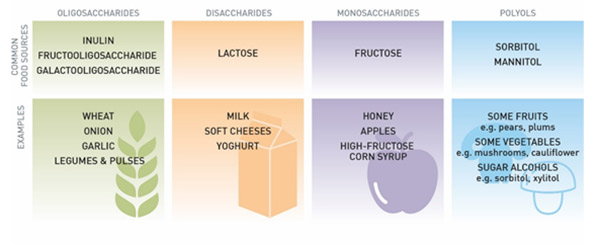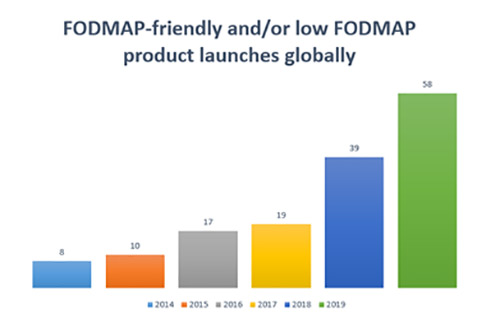One in 5 adults develops Irritable Bowel Syndrome (IBS) at some point in their lives. The FODMAP diet can help alleviate the symptoms of IBS, but it can be a challenge for those following it to get enough fibre. By developing low FODMAP products and adding easily digestible, FODMAP-free fibres, food and drink manufacturers can support those on a FODMAP diet maintain a healthy gut.
What are FODMAPs?
FODMAP stands for fermentable oligosaccharides, disaccharides, monosaccharides and polyols. These are types of carbohydrates and sugar alcohols found in various food items that the body can sometimes have difficulty metabolising.
What is a FODMAP diet?
For some people, FODMAPs can cause bloating, stomach pain or other digestive problems. The FODMAP diet eliminates or reduces the number of FODMAPs to help alleviate these symptoms. It has been shown to be particularly effective for those suffering with Irritable Bowel Syndrome (IBS), with as many as 3 in 4 reporting an improvement in symptoms when following the diet1.
The diet involves cutting out all foods containing FODMAPs for an initial period, and then slowly reintroducing some FODMAPs back into the diet, identifying one by one which types the individual can tolerate and in what amount. FODMAPs should not be completely eliminated from the diet over the long term because they are important for gut health. The aim is to identify and limit the ones that trigger gastrointestinal problems and build back in the others.
Which foods contain FODMAPs?
Are there any negative side effects of a low FODMAP diet?
Some FODMAP components promote the growth of healthy bacteria in the gut and are therefore beneficial for most people. This diet is therefore not recommended to those who do not suffer with IBS.
For the same reason, it is important that anyone on the FODMAP diet reintroduces as many FODMAPs as they are able to tolerate in the second phase of the diet.
An additional challenge of this diet is that it can often be low in fibre, as many high-fibre foods (such as certain legumes, fruits and cereals) are restricted or excluded. It is possible to obtain sufficient fibre from other low FODMAP sources – that being said, the dieter should seek to consume foods that have a higher content of soluble fibres than insoluble fibres2. This is because insoluble fibres are not as easily digested and can therefore cause gastrointestinal discomfort, which would be somewhat counterproductive to the purpose of being on a FODMAP diet.
How can food and drink manufacturers help ensure those following the FODMAP diet get sufficient fibre?
More and more low FODMAP products are coming onto the market – the number of new product launches globally has risen from 8 in 2014 to 58 last year. Low FODMAP products can be particularly helpful for those new to the diet who are trying to navigate the complex list of restricted foods in the first phase. These products can also receive certification as suitable for FODMAP dieters, making it easier for consumers to identify them.
On the issue of fibre, while dieters can achieve sufficient intake by carefully selecting natural sources of soluble fibre that are also low in FODMAPs (such as oats, carrots or oranges), manufacturers can assist them by fortifying low FODMAP products with additional fibre.
For example, Tate & Lyle’s PROMITOR® Soluble Fibre does not contain any FODMAPs and is shown to have excellent gastrointestinal tolerance compared with other fibres such as inulin or fructooligosaccharides. Clinical trials have shown that multiple doses of PROMITOR® can be consumed several times a day without any gastrointestinal discomfort.3
Food and drink manufacturers can therefore play a role by providing low FODMAP, high fibre options to dieters who want to ensure sufficient fibre intake without compromising their diet or their gastrointestinal comfort.
Contact us to learn more about adding fibre to low FODMAP products.
Disclaimer: This article is for general informational and education purposes and is not intended to be an endorsement or in any way a promotion of the FODMAP diet, nor is it intended to be a substitute for professional medical advice, diagnosis, or treatment. Always seek the advice of your physician or other qualified health provider with any questions you may have regarding a medical condition
1 Staudacher, H. M.; Whelan, K.; Irving, P. M.; Lomer, M. C. E., Comparison of symptom response following advice for a diet low in fermentable carbohydrates (FODMAPs) versus standard dietary advice in patients with irritable bowel syndrome. In: JOURNAL OF HUMAN NUTRITION AND DIETETICS. 2011; Vol. 24, No. 5. pp. 487 - 495.
2 Db SSC Rao, S Yu, A Fedewa. Systematic review: dietary fibre and FODMAP ‐restricted diet in the management of constipation and irritable bowel syndrome. Aliment Pharmacol Ther. 2015 Jun;41(12):1256-70. doi: 10.1111/apt.13167.
3 Housez, B., M. Cazaubiel, C. Vergara, J.M. Bard, A. Adam, A. Einerhand, and P. Samuel. (2012). “Evaluation of digestive tolerance of a soluble corn fibre.” J Hum Nutr Diet 25:488–96.


